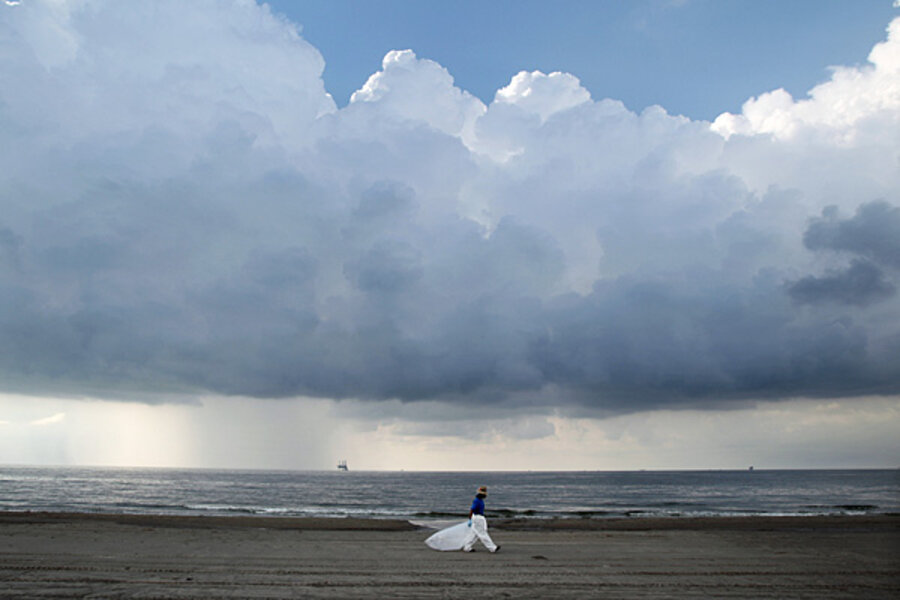BP oil spill could make Gulf hurricane season 'devastating'
Loading...
| Hammond, La.
The 2010 Atlantic hurricane season opens today, and with it concerns over the effect the BP oil spill could have on coastal ecosystems if a major storm moves into the northern Gulf of Mexico and reaches land.
On one hand, hurricane forecasters and federal emergency officials say the first concern in any hurricane that makes landfall will be people. Yet healthy wetlands along the Gulf Coast – mainly west of the Mississippi Delta – are widely seen as a first line of defense against the storm surges tropical cyclones push ahead of them.
Marshes in and around the Delta region are already under assault. Sea levels are rising, and the widespread use of levees along the Mississippi River has starved the wetlands of fresh sediment the Mississippi River once delivered.
IN PICTURES: Louisiana oil spill and Notable hurricanes in the past two decades
If oil from the Deepwater Horizon blowout invades the wetland soils, it can kill off marsh grasses at the roots, increasing the rate of erosion, ecologists say. With chemical dispersants mixed in, the brew also would be toxic to small marine animals that form a vital part of a marsh's food chain.
A range of seasonal hurricane forecasters have indicated that this season is likely to be significantly more active than normal. Both the federal government and BP, meanwhile, have suggested that the leak might not be stopped before a relief well is completed in August.
"A hurricane in the Gulf of Mexico this year would be devastating," says Qin Chen, an associate professor of civil and environmental engineering at Louisiana State University in Baton Rouge.
If a hurricane comes, does oil containment stop?
So far, the blowout 5,000 feet below the sea surface has pumped between 21 million and 34 million gallons of oil into the Gulf using the current federal estimates of daily flow. Several marine scientists suggest the amount could be much higher.
The hurricane season's onset had prompted federal officials as well as BP, which owns the lease to the well the Deepwater Horizon was drilling, to start developing procedures for suspending oil-containment operations if a storm approaches.
With BP's focus now almost solely on containing, not stopping, the oil, the company is also looking at different ways to gather it. BP plans to channel any oil it gathers at the well into tanker ships on the surface. But it is considering some kind of platform that can withstand harsh weather, said US Coast Guard Adm. Thad Allen at a briefing with reporters today.
Major hurricanes – those with sustained winds exceeding 111 miles per hour – have popped up in the Gulf during June and July, but they are rare, says Philip Koltzbach, the lead researcher producing and updating seasonal Atlantic hurricane forecasts at Colorado State University in Fort Collins. "A major landfalling hurricane before the first of August is unlikely," he says.
The first two months of the season typically deliver tropical storms or weak hurricanes. Yet even lesser storms between now and then can be disruptive.
Hurricane could delay relief well
One of the most immediate affects: a storm could impose delays from a few days to several weeks on efforts to contain the oil spewing from the blowout or on efforts to drill relief wells.
Ahead of a storm, a rig must be secured and crews evacuated before seas get too rough or flying conditions too poor to evacuate safely. Most offshore rigs are designed to withstand winds of up to about 115 m.p.h. – the low-end of a Category 3 storm – before they sustain serious damage, industry analysts say. But any repairs will take time, allowing more oil to flow into the Gulf.
As for the oil-bearing water, both tides and summer's generally southerly winds tend to push the oil toward the coast. The latest 72-hour forecast from the National Oceanic and Atmospheric Administration has generally southwesterly winds pushing the oil against the western edge of the Mississippi River's "bird's foot" delta and and onto the exposed coastline to the west, as well as toward the barrier islands off Alabama's Mobile Bay.
To some extent, the intense winds and waves of a hurricane could help to break up an oil slick. Still, if hurricane makes landfall with the oil so close to the coast, some surface oil could be driven inland by a storm's surge. Inside the marsh, waves would not be intense enough to break up oil into tiny droplets.
The importance of storm sediment
How a storm stirs up sediment can also affect where and how much oil is retained in a marsh, Dr. Chen explains.
Tiny oil droplets tend to stick to sediment grains in the surge, which could be borne into the wetlands. Since a surge's retreat occurs far more slowly than its arrival, the oil-bearing grains would merely fall out of the water and onto the bottom of marshes as it slipped back into the Gulf, leaving a layer of oil-bearing sediment atop the original layer of marsh mud.
Using hurricane Gustav in 2008 as a test case, Chen has made an initial attempt to model the effect that storm might have had in the Gulf this summer. The storm made landfall as a Category 2 storm, with sustained winds of between 96 and 110 m.p.h. As it hit Louisiana, its eye slid northwestward along the eastern edge of Achafalaya Bay.
That put the strongest winds and storm surge the northeast quadrant of the storm, where they likely would have driven oil and oil-bearing sediment deep into the marshes of Terrebonne and Barataria Bays.
IN PICTURES: Louisiana oil spill and Notable hurricanes in the past two decades
Related:





